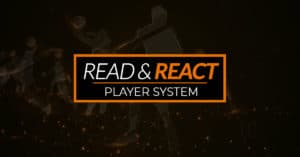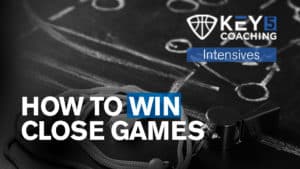This article was published today in Basketball Times so I thought it may be of some interest to the Tribe, especially those who are new to the R&R. Several events in my life along with many lingering thoughts about basketball ultimately led to the creation of the Read & React. This article describes a couple – there are more that may be published in the future. There is very little teaching in here, it’s just a story about how I reached my breaking point with traditional offense.
Just over 10 years ago, after a rather average season, my assistant coach asked me if I was happy. It didn’t take long for the words, “Not particularly” to escape my lips. He knew that I was frustrated with the season, with myself, with… the job. “What would you do differently if you could scrap our entire program and start over?” he probed. Again, it didn’t take me long to respond because I’d thought about that very thing almost every day. “I would teach our kids how to play the entire game by principle.” I, of course, knew his next question before he said it, “Why don’t you do it?”
The honest answer was simple: I didn’t know how. I had a lot of pieces; a lot of 2-man and 3-man game principles, but not the entire thing. It seemed like a pretty tall order to create a seamless offensive system that would tie together transition, man-to-man, and zone without contradiction. And, it couldn’t be limited to only one formation like 5 OUT, or demand a certain type of players, or a particular style of play because my players and talent level changed every year.
Of course, the frustrations I expressed that night sitting across the table with my assistant weren’t the result of a single season. They weren’t even the result of a specific school. They had been building from the day I decided to become a coach.
When I entered the coaching field, I had a very simple goal: continue to enjoy the game that I had been playing, while teaching others how to play it. Pretty lame, huh? No Hollywood director’s going to make a movie out of that! It goes without saying that I wanted to win. I wanted to win every game and championship that was possible, but I wanted that “Road to the Championship” to include the day-to-day joy of teaching kids how to play the game.
I found out quickly that although I could teach math to any one at any time of the year, when it came to basketball, it was illegal to teach before a certain date. Oh sure, I could work with two players at a time which meant if I wanted to teach 12 players per day, at 2 per hour, I would spend an extra 6 hours per day after school! That puts me home at about 10:00 pm! And people wonder why coaches dress funny…
So when can I legally begin? Oh wow! Three weeks before the first game! How generous! Of course, with tryouts included, that means I’ll have about twelve or thirteen practice days before we begin to tally those W’s and L’s that will determine whether I have job next year or not! (Of course, when I was hired, an administrator assured me that wins and losses were not a factor in my employment. Yeah, right. This is the same suit that told me my summers would be free!)
And so, every season began the same way: Start with the fundamentals and as the players master them, move into the principles that allow them to play as an orchestrated team. Makes sense. Except, always without question with about 5 days of practice left, desperate realization would set in. Not only has there not been enough time for my players to grasp the fundamentals and principles of the game, they also can’t break a press, get the ball in-bounds, run a primary fast break, secondary fast break, man offense or zone offense. Not only that, when I explain the multiple defenses that we’re going to run, they look at me like a cow looking at a new gate!
So, with only 5 practice days left before our first game against our powerhouse cross-town rivals (generously scheduled by our girls coach because she’s loaded with talent and will surely win), I resort to what my high school coach did: I drop all pretenses of teaching the game and drill my players to run plays like a bunch of little robots.
And sure enough, my players became very good at running plays, but they never learned how to play. Naturally, once we got into post-season tournament play, all of my tricky plays were scouted and you can imagine the rest. When little Johnny can’t pass from point A to point B, he panics and passes to anyone (hopefully with the same color jersey) who uses his 1-on-5 skills to force up a shot. I then pray that my football players, who are just now getting used to a round ball, can rebound some of the misses and put them back in.
Is there any wonder why I was frustrated? I needed the summers “off” just to recover enough to convince myself that I could do a better job the next year. And, every spring I was even more motivated to go to every coaching clinic my 1975 Ford Maverick could get me to. I would take copious notes on the 15 set plays and quick-hitters of the current NCAA champion who used them to win with his 18 former high school All-Americans that he had hand-picked to fit his now famous “Fabulous Fifteen Set Plays and Counters Offense.”
And every fall, I deluded myself into believing that little Johnny and his teammates back home could run this championship offense with its 100 counters to trapping, helping, rotating man-to-man defenses!
Of course, next year, 19 of my 20 opponents would run zones.
Shortly after that conversation with my assistant, I buried myself in the video room. I guess I was hoping to make myself feel better about the choices that I had made. Or, maybe I would find some answers.
Using the previous season’s videotapes, I charted all the points we scored from free throws, offensive rebounds, fast breaks, set plays, broken plays, etc. and found an unsettling ratio.
80% of our points came from broken plays, transition, and other principled basketball.
We only scored the way our set plays were designed about 20% of the time.
But in practice, the ratio was the opposite: we spent 80% of our time on set plays and less than 20% of the time on principled basketball.
Why was I spending 80% of our time on only 20% of our point production?
Then, something happened. I’d like to say that something changed, but I hadn’t done anything different – something just happened. A group of 6 players who had played together since 7th grade reached Varsity and because of that, I experienced some success. Ultimately, they finished their 6-years (7th – 12th) with a record of 123 wins and 13 losses.
Were they talented?
Yes, but not to the extent you might think. Only two went on to play at the collegiate level. Their real talent was their coordinated effort. They knew each other. They moved like a school of fish.
Was I responsible for this? Had I suddenly become a coaching genius?
Nope. Our success was due mostly to the fact that they had played together for 6 years.
In fact, each year of their career was characterized by fewer plays and more principles.
And that was the last nudge I needed. Coaching fulfillment could not be found in a set play. I remembered what I had said to my assistant coach, “If I could change everything and start from nothing, I would teach players how to play by principle.”
The next five years I worked toward that goal. Not to build another motion offense – those required that all of my players have a high basketball I.Q. and a complete set of skills. I couldn’t rely on getting those types of players year in and year out.
I wanted to build something better, something… more complete.
I wanted something that had the advantages of Set Plays, Motion Offense, and Continuity Offense without the disadvantages of each. I wanted it to be easily transferrable from one coach to another and from a coach to his or her players. I wanted it to develop the skills of the players while they were learning the offense – this way you could train your players’ I.Q.’s and skills without leaving the offense. I wanted it to be flexible enough to accommodate any type of player, any type of formation, and any type of coaching philosophy. And, I wanted it to be capable of attacking any type of defense; zone or man.
It took 25 years of coaching to thoroughly identify my frustrations with the current systems of offense. And it took 5 years “in the lab” arranging and rearranging pieces and parts to solve them.
There is a better way to teach offense. There is a better way to play. A way that gives freedom to players without removing accountability. A way to collapse timeframes in practice so that you can get the most out of your ever diminishing gym time. A way to coordinate players of different skill levels, with different I.Q.’s into a school of fish. A way that can free you from frustration.
There is a better way and it’s the Read & React Offense. (Those of you reading this on the Tribe hopefully already know this.)






